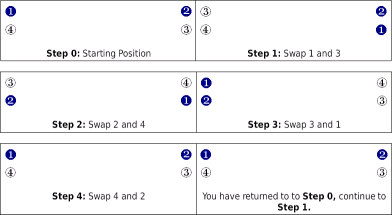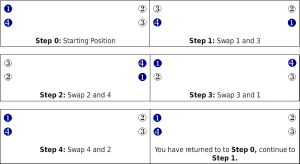Medieval Baltic


The Viking Age
- A sewing basket
- Skjoldehamn hood and tunic
- Garðar and Heynes mittens
- Mitten article translation
- Triangular shawl
- Whipcord braiding
- Images of Norsewomen
- Belt Hardware in Norse Female Graves
- Open-Fronted Apron-Dress (PDF)
- Apron, strap, and underdress textiles (PDF)
- Runic embroidery and leatherwork
- Moksha puloker braids
- Omega brooches (PDF)
Whipcord Braiding
'Viking' whipcord braiding, also called interlocking, 'spoon tossing' (Thies, 2006) 'combat braiding' (Livinghistory.co.uk), 'slyngyng' (Soper Lane) and possibly 'slyngva-støkkva' (Livinghistory.co.uk). It is a technique for making cords quickly, using bobbins. (Note that there is also a foot-weaving method, called slynging, that is sometimes used to finish the hems of items, which is a different technique. For more information see Østergård's Woven into the Earth.) It appears to have been first mentioned in Hald's Ancient Danish Textiles from Bogs and Burials, and has developed a life of its' own on the internet, and in museum displays (Thies, 2006; Bjornsson, 2002). The evidence for this technique being used in the Viking Age is slim, but the finished cord is indistinguishable from a cord made by plaiting with four strands, so it is not impossible, however I personally am skeptical.
I have helped to run a class on the basic, four-strand braid, and a basic description of the technique can be found in this PDF file.
For better illustrated, and possibly clearer instructions, please see the resources list of other websites below.
Different people have different ideas, about the size and weight of bobbins, and if it is a one- or two-person activity. I personally use fairly heavy lace bobbins, or clothespegs, and braid by myself. The clothespeg-bobbin idea shows up in bobbin lace books (Fuhrmann, 1985; 37) and is also used by Eithini ingen Talorgain (2005) for whipcording. However, there seems to be very little information about how to wind thread on to your bobbin.
Bobbins
Whether a purpose-built bobbin, a lace bobbin, or a clothespeg, in general they will have the same features: A head at the top of the bobbin, a shank to wrap your thread or string around, and a handle to act as the weight.
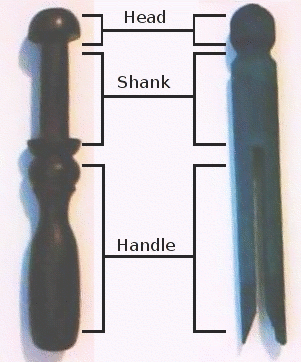
Fig 1: The three basic parts of a bobbin. (After Fuhrmann, 1985; 37) My purchased bobbins are, coincidentally, the same size as a clothespeg from a craft shop.
Take your bobbin, and either tie a slipknot (Hudson, 2009), or if you are using doubled-up threads with loops still on the ends, use a cow hitch formed in the bight: form the end into a B-shape, and then insert the shank through the two loops (Hudson, 2009). If you are using a clothespeg, it is easier to pass the loop over one of the 'legs' of the pin. It seems to help keep the clothespegs stay balanced and upright when braiding with them, as well.
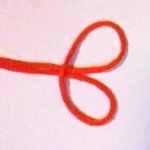
Fig 2: Forming the end of your loop into a B-shape.
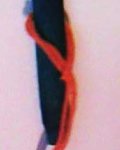
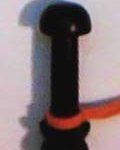
Fig 3 and 4: The 'slipknot' attached to the shank of the bobbin, or a leg of the clothespeg.
Wrap the thread around the shank of your bobbin, until there is approximately a hand span of unwound thread left. Tie a half-hitch around the shaft (Hudson, 2009), or I use a clove hitch, as the head of the bobbin will keep the knot in place for a short while. (Grog, 2008)
Do that another three times, and you will have four bobbins to begin your whipcord braiding!
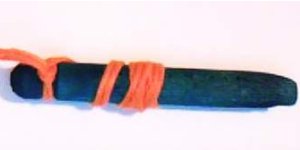
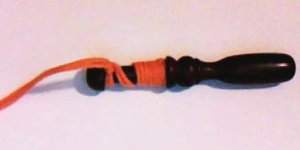
Fig 4 and 5: 'Dressed' lace bobbin, and clothespeg.
Recreating the Cords on the Skjoldehamn Hood
The late 11th century find from Skjold Harbour (Skjoldehamn), in Norway, included a woollen hood with two cords attached, just below ear height. Although what precisely these cords were designed for was unknown, they were apparently made in a four-strand braid technique to produce a 'clockwise' spiral, with doubled-up strings (Løvlid, 2009; 47). In the photograph, and braiding diagram, it appears this is a Z-twisting spiral (Løvlid, 2009; 48). This can be achieved by whipcording, following the steps in figure 6, below:
Fig 6: Steps to replicate the Skjoldehamn braid. Click on image to enlarge.
Although there is no way to know for sure how this braid was made -- by hand, with bobbins, or another method -- this technique is certainly a plausible one. For more information about the find from Skjold harbour, please refer to my summary.
Incidentally, to create a counter-clockwise or S-twisting spiral, you can follow the steps in figure 7:
Fig 7: Steps to create an anti-clockwise braid. Click on image to enlarge.
What else can I do with clothespeg bobbins?
While it may be difficult to make round braids by yourself, with more than four strands, it is quite easy to use more bobbins and fingerweave. Fingerweaving is described by Hald (1980; 242) as a 'diagonal braiding technique' that produces a tabby weave. There are possible examples from the Mammen and Oseberg burials, (ibid., 242, 249 112, 117), and a medieval Swedish box containing braid (ibid., 242).
Bibliography and Resources
All webpages checked 22 September 2022.
- Anonymous (2007?) Viking Whipcord Braiding [YouTube Video]
Shows the 'throwing' style of this technique, where you pass the bobbins between two people. Ilustrates very clearly the diagonally-opposite thread passes. - di Benedetto Falconieri, Giuliana (2008) Viking Whipcord [Internet Archive PDF]
- Bjornsson, Danr (2002) Whipcord Braiding Bobbins [Internet Archive PDF]
- Fuhrmann, Brigita (1985) Bobbin Lace: An Illustrated Guide to Traditional and Contemporary Techniques (New York: Dover Publications) ISBN: 04-862-4902-6
- Grog LLC. (2008) Animated Knots by Grog: The Clove Hitch.
- Hald, Margarethe (1980) Ancient Danish Textiles from Bogs and Burials (Copenhagen: National Museum of Denmark) ISBN: 87-480-0312-3
Please note this publication has been digitised by the Centre for Textile Research, University of Copenhagen, and can be accessed via the Margrethe Hald Archive - Hudson, Peter (2009) I Will Knot!
- ingen Talorgain, Eithni (2005) Whipcording
- Livinghistory.co.uk (2009) Combat/battle braiding?
Note: this link is dead. - Østergård, Else (2004) Woven into the Earth: Textiles from Norse Greenland (Aarhus: Aarhus University Press)
- Løvlid, Dan Halvard (2009) Nye tanker om Skjoldehamnfunnet
Masters Thesis in Archeology, Bergen University
Now hosted on Løvlid's website [PDF] - Soper Lane (2006) trollen braids? Page 2.
Note: this link is dead. - Thies, Jennifer (2006) Interlocking or Making a Viking Whip-Cord
- Úlfviðardóttir, Ásfríðr and inghean ui Aonghusa, Meadhbh (2009) 4strand Whipcord Braiding
Translation ©2009-10 Rebecca Lucas. Text, diagrams, and photos: 
